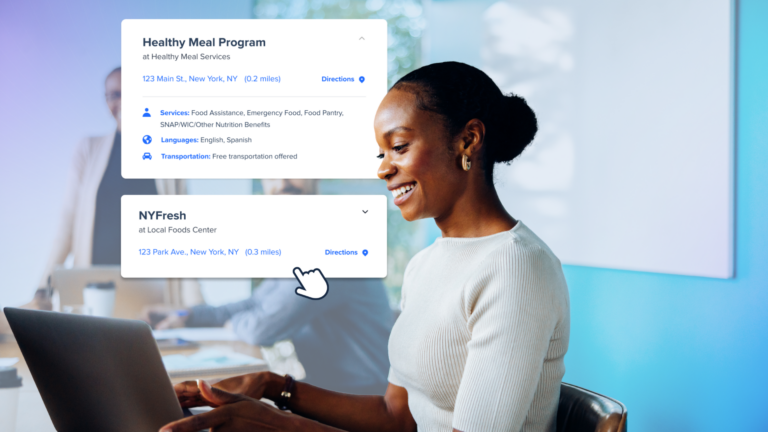
5 Tips for Building Effective Community Partnerships
Brian Longo, a Customer Success Account Manager at Unite Us, shares his tips for building effective community partnerships.
We know that coordinated care teams can help improve community health outcomes by addressing health from every angle. Our technology facilitates the journey, starting from a client’s first interaction with a care provider. Onboarding organizations into our software is simple, but engaging those organizations to become active and collaborative partners is much more complicated. Building effective community partnerships requires a personal connection that takes time to build. While technology can help streamline the process of building patient-centered networks of care, a human touch is still essential.
Recently, Unite Us hosted a webinar, The Secret to Provider Engagement. This allowed a group of our network leaders to share their best practices, learn from other community experts, and inspire dialogue around the importance of engaging your community’s service providers. The conversation included over 35 of our network leaders, several of whom spoke up about their experiences working with their partners and clients daily.
As a Customer Success Account Manager, I work hand-in-hand with network leaders to build and maintain high-quality networks through active partner engagement. Here are five proven methods for building effective community partnerships.
1. Understand where a service provider lies on the engagement continuum before you interact with them.
You shouldn’t approach every community partner in the same way. It is crucial to know your audience and tailor your communications to fit their lens. As said by Nicole R. French, Psy.D., of Veterans Bridge Home, “It is important to understand what an organization’s mission is. What tools they use to support their mission; to understand their workflows.” When approaching service providers, there are always different variables at play, so remember to keep their context in mind. Knowing as much as you can about each partner will help you understand their pain points and the needs of their organization. This information prepares you to address them appropriately and deliver the value proposition. Service provider engagement depends on understanding the relationship between that partner, the network, and the community.
2. Be personal—in real life and online.
People appreciate authenticity. Use the right language! Say “we” or “us,” not “you” or “them.” Be conscious of your tone and word choice. This goes along with method number one; you’re going to want to know a little about each provider in order to form that genuine connection. Find out what each provider needs, and if you don’t know, ask. Ask open-ended questions. Get to know their stories. Don’t hold back from sending personalized emails. Whether it’s welcome emails, informational emails, invitations to community events, a simple message takes a few minutes to write but could mean the world to someone who feels disconnected.
3. Build trust by using all the tools available to you and solving people’s problems before they know they exist.
Leverage the tools at your disposal. All service providers in our networks are equipped with the software, the information, and perhaps most importantly, the data that they should need to show potential partners the network’s value. Aggregate, real-time data is tremendously powerful, so be prepared to use it. These numbers can help you address any objection a prospective partner may have and elicit the value collaboration brings to your organization. Always leave people with something to remember you by. A pamphlet, a flyer, or even a business card is a tangible reminder that can both educate your partners and remind them that you’re there. Share personal anecdotes to relate to your audience. If you continue to act as a reliable source of information, personalized support, and effective solutions, people will see the value in your network. Use your tools.
4. Set expectations early on to make communication smooth throughout the whole process.
Make your ask clear and follow through. When building a relationship with your community partners be sure to relay what you expect of them and what they can expect from you. During the Unite & Learn webinar, Brandon Wilson of the Asheville Buncombe Community Christian Ministry spoke about how he breaks providers into groups based on the number of referrals they send. This helps him easily survey providers to see where they stand. If they aren’t reaching benchmarks, he knows to reach out. Keeping an eye on partner progress will help to gauge network success. By establishing a common set of standards in the beginning and following through on these standards throughout, you ensure the foundation for lasting engagement.
5. Hang in there—building effective community partnerships takes time.
Formulate a plan and stick to it. Network building is a gradual process and there’s no good way to rush it. As put perfectly by Paul Berry, USO of North Carolina, “You have to be where they’re at. If I get five minutes with my provider it has to be the most impactful five minutes of my day.” Spend time with your partners. Offer to walk them through their onboarding and registration processes. Invite them to In-Progress Reviews, weekly calls, and in-person meetings. Assess their progress and share what you know. When it comes to keeping your partners engaged, consistency is key.
Each of these strategies can be used differently depending on your partners’ unique needs. At Unite Us, we strive to share the lessons we learn with each community we work in. We know that technology and effective community partnerships are decisive in building healthier communities. The tools we’ve built can help your community shape thriving, scalable, and sustainable networks of service providers working together to help every client that walks through their doors.
A special thanks to our partners at The Institute for Veterans and Military Families, NCServes, and all who have contributed to our work in building healthier communities together.
Interested in learning more about how to bring Unite Us to your organization?



